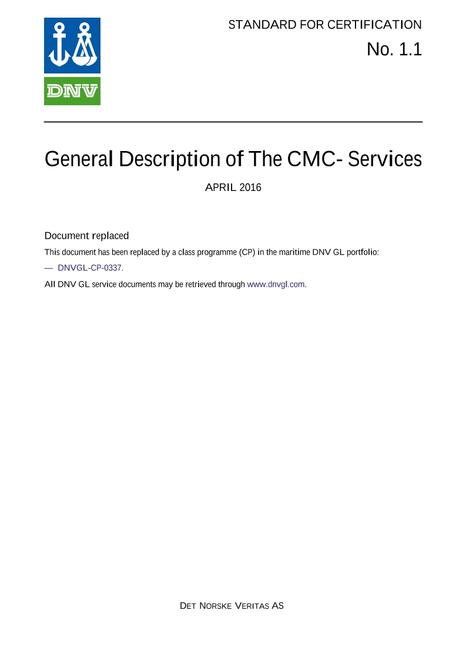-
-
Available Formats
- Availability
- Priced From ( in USD )
-
Available Formats
-
- Secure PDF 🔒
- Immediate download
- $57.00
- Add to Cart
-
- Printed Edition
- Ships in 1-2 business days
- $57.00
- Add to Cart
Customers Who Bought This Also Bought
-

DNV DNV-OSS-302
Priced From $57.00 -

DNV DNV STD CERT 1.1
Priced From $57.00
About This Item
Full Description
The requirements are established on the supposition that the regulations of international conventions and the rules for main class are complied with.
Within the operational limits of the applicable class notation the rules aim to safeguard that the officer of the navigational watch has full control of all the primary functions he/she is responsible for, including the look out function required by COLREGS72, single-handed.
Moreover, the rules acknowledge that the modes of operation and the manning of the bridge varies in accordance with internal and external conditions like availability of technical systems, type of waters, traffic density and weather conditions. The rules therefore aim to provide a bridge arrangement being suitable for an enlarged bridge team when operational or legislative conditions so requires.
The rules stipulate requirements for the following areas aiming to manage the risk of bridge system failures:
design of workplace, based on analyses of functions to be performed under various operating conditions and the technical aids to be installed
bridge working environment, based on factors affecting the performance of human operators
range of instrumentation, based on information needs and efficient performance of navigational tasks
equipment reliability applicable to all types of bridge equipment, based on common requirements to ensure their suitability under various environmental conditions
performance of different types of bridge equipment, based on their specific functions
human-machine interface, based on analyses of human limitations and compliance with ergonomic principles
information on the ship’s manoeuvring characteristics, based on the competence needed for safe performance of operations involving ship manoeuvring
tests and trials based on the need to ensure that technical systems perform in accordance with their approved specifications before being relied upon and used in practical operation
and give guidance concerning qualifications essential for mastering the navigational systems installed.
The reliability and availability of equipment and systems for steering and propulsion, although essential for safe navigation, is addressed by the rules of main class. The scope of this chapter concerning such equipment is:
the location and arrangement in the wheelhouse
the human-machine interface
any integration and/or interface with navigational equipment.
The scope of this chapter concerning systems and equipment being additional to those related to safety of navigation, but important to the safety or security of the ship, such as cargo/ballast system, safety monitoring systems, fire systems, GMDSS equipment, security equipment, hull monitoring system, and similar systems is:
the location and arrangement in the wheelhouse
the noise and illumination level
any integration and/or interface with navigational equipment.
On ships fitted with an Integrated Navigation System involving automatic control of heading and/or speed The Bridge System is only considered compliant with the code of safe navigation when the officer of the navigational watch holds a certificate of competence in accordance with the requirements of Sec.9.
Document History
-
DNV DNV-RU-SHIPS PART 6 CHAPTER 8
NEWBUILDINGS SPECIAL EQUIPMENT AND SYSTEMS - ADDITIONAL CLASS - Nautical Safety- Most Recent
-
DNV DNV-RU-SHIPS PART 6 CHAPTER 8
currently
viewing
NEWBUILDINGS SPECIAL EQUIPMENT AND SYSTEMS - ADDITIONAL CLASS - Nautical Safety- Historical Version
-
DNV DNV-RU-SHIPS PART 6 CHAPTER 8
NEWBUILDINGS SPECIAL EQUIPMENT AND SYSTEMS - ADDITIONAL CLASS - Nautical Safety- Historical Version
-
DNV DNV-RU-SHIPS PART 6 CHAPTER 8
NEWBUILDINGS SPECIAL EQUIPMENT AND SYSTEMS - ADDITIONAL CLASS - Nautical Safety- Historical Version
-
DNV DNV-RU-SHIPS PART 6 CHAPTER 8
NEWBUILDINGS SPECIAL EQUIPMENT AND SYSTEMS - ADDITIONAL CLASS - Nautical Safety- Historical Version
-
DNV DNV-RU-SHIPS PART 6 CHAPTER 8
NEWBUILDINGS SPECIAL EQUIPMENT AND SYSTEMS - ADDITIONAL CLASS - Nautical Safety- Historical Version
-
DNV DNV-RU-SHIPS PART 6 CHAPTER 8
NEWBUILDINGS SPECIAL EQUIPMENT AND SYSTEMS - ADDITIONAL CLASS - Nautical Safety- Historical Version
-
DNV DNV-RU-SHIPS PART 6 CHAPTER 8
NEWBUILDINGS SPECIAL EQUIPMENT AND SYSTEMS - ADDITIONAL CLASS - Nautical Safety- Historical Version
-
DNV DNV-RU-SHIPS PART 6 CHAPTER 8
NEWBUILDINGS SPECIAL EQUIPMENT AND SYSTEMS - ADDITIONAL CLASS - Nautical Safety- Historical Version
-
DNV DNV-RU-SHIPS PART 6 CHAPTER 8
NEWBUILDINGS SPECIAL EQUIPMENT AND SYSTEMS - ADDITIONAL CLASS - Nautical Safety- Historical Version
-
DNV DNV-RU-SHIPS PART 6 CHAPTER 8
NEWBUILDINGS SPECIAL EQUIPMENT AND SYSTEMS - ADDITIONAL CLASS - Nautical Safety- Historical Version
-
DNV DNV-RU-SHIPS PART 6 CHAPTER 8
NEWBUILDINGS SPECIAL EQUIPMENT AND SYSTEMS - ADDITIONAL CLASS - Nautical Safety- Historical Version



